Explore Free iPhone Customization Apps for Unique Styles
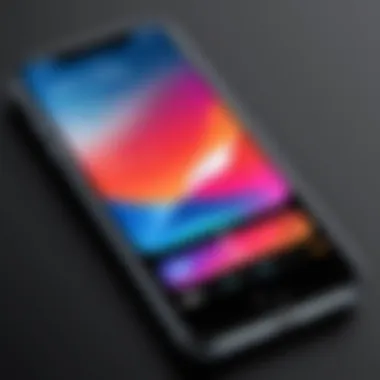

Intro
Customization has become a significant part of the smartphone experience, especially for iPhone users. As technology evolves, so does the demand for personalized devices. Free iPhone customization apps allow users to tailor their devices according to their preferences, enhancing both aesthetics and functionality. This article delves into various aspects of these applications, guiding users through their unique features and practical applications.
Overview of the Technology
Free iPhone customization apps represent a variety of technologies designed to enhance user interface and personal expression. These applications typically integrate with the iOS ecosystem, providing seamless usability while offering a range of customization options.
Key Specifications
- Compatibility: Most apps are compatible with recent iOS versions, ensuring a broader user base can access their features.
- User Interface Design: Many of these apps feature intuitive interfaces that allow even novice users to customize their devices without extensive tech knowledge.
- Resource Efficiency: These applications are designed to use minimal device resources, preventing performance degradation while running in the background.
Unique Selling Points
- Variety of Themes: Users can choose from a wide range of themes, allowing for a personalized aesthetic.
- Widgets and Icons: Customizing icons and widgets is a key feature, enabling users to create a unique home screen look.
- Functionality Enhancement: Some apps enhance functionality with improved organization tools, such as advanced folder management or task automation.
Design and Build Quality
The design and usability of these applications are crucial for user satisfaction. A well-constructed app not only serves its function but also enhances the overall experience.
Material Used
In the context of software, material refers to the design principles and guidelines that the apps follow. Most customization apps adhere to Apple's Human Interface Guidelines, ensuring a cohesive look and feel consistent with iOS standards.
Ergonomics and Usability
User-friendly designs are critical. Apps focus on easy navigation, minimal clutter, and accessible settings to cater to a diverse audience, from tech enthusiasts to casual users. A clean layout promotes user engagement, making the customization process enjoyable.
"The ability to personalize one's device is not merely a trend; it's about identity and expression in the digital age."
Prelims to iPhone Customization
Customization of the iPhone is not just a trend; it reflects the individuality of users. Every device can look the same at first glance, but personalization allows one to express who they are. This article tackles the importance of iPhone customization and delves into the tools available to achieve this.
The relevance of customizing an iPhone lies in both aesthetics and functionality. Many users want their devices to stand out, whether it’s through unique wallpapers or distinct app arrangements. This not only enhances the visual appeal but makes navigating through apps more efficient. A carefully curated home screen can lead to improved productivity. Furthermore, customization enriches user engagement, making the interaction with the device more enjoyable and personal.
Moreover, exploring these customization options reveals insights into how technology can shape our experience. The apps designed for customization often come with various features, offering tweaks that cater to both aesthetic preferences and practical needs. As technology evolves, so do the possibilities for customization, urging users to rethink how they interact with their devices.
Let’s examine why one would consider customizing an iPhone and the different ways this can be accomplished.
Why Customize Your iPhone?
Customizing an iPhone can drastically change the user experience. Firstly, personalization creates a sense of ownership. Users feel more connected to their devices when they can modify its appearance and settings.
Secondly, personalization caters to specific preferences. Users may have different needs, such as quick access to frequently used apps or a particular color scheme that speaks to them. Being able to adjust icons and arrange apps can streamline workflows and improve efficiency.
Thirdly, customization enhances user motivation. A fresh look or layout can breathe new life into an iPhone that might appear stagnant after extended use. The renewed interest often leads to exploring and utilizing features that might have been overlooked.
Finally, customization reflects personal style. In a world of mass production, the ability to customize technology is an empowering aspect. It allows users to curate their experience based on their unique tastes and lifestyle.


Overview of Customization Options
Understanding the various options available for iPhone customization can enhance the experience. These options can be broadly classified into several categories:
- Wallpapers and Themes: Changing the wallpaper is a simple yet effective way to personalize the device. Themes can also alter the appearance of icons and app arrangements.
- Widget Placement: Widgets are incredibly useful and can be tailored to show relevant information at a glance. Users can choose which widgets to display and where to place them.
- App Icons: Various apps help change the app icons on the home screen. This option allows users to create a cohesive visual theme.
- Shortcuts and Automation: The Shortcuts app on iOS allows users to automate tasks, which not only customizes functionality but also improves efficiency in daily routines.
- Ringtones and Alerts: Custom sounds for ringtones and notifications can also allow for personalization, making the device more unique to its owner.
Through these options, iPhone users can create an interface that resonates with their daily lives and enhances usability. This article will further explore free customization apps designed to bring these options to life.
Understanding Free iPhone Customization Apps
The wave of customization has revolutionized how users interact with their devices, especially iPhones. Understanding free iPhone customization apps is essential for anyone wishing to enhance their mobile experience. These applications open various pathways to personalize the aesthetics and functionality of devices, allowing users to curate an interface that reflects their individual tastes and preferences.
Customization goes beyond mere visual appeal. The right apps can improve efficiency, organize content better, and optimize the overall usability of the device. By exploring these tools, users can gain control over how they interact with their iPhone, making utility and personal expression inseparable.
Classification of Customization Apps
Customization apps can be divided into several categories based on their primary functions. This classification helps users identify which app aligns with their specific needs. Common types include:
- Wallpaper Managers: Apps focused on providing a variety of backgrounds, themes, and lock screens.
- Icon Pack Apps: Programs that offer different designs for app icons, ensuring that users can have a cohesive look.
- Widget Design Apps: Tools that enable customized widgets for the home screen, from calendars to weather updates.
- Launcher Apps: These applications redefine the home screen layout, allowing for organization and accessibility.
Each category addresses unique aspects of customization, catering to varying priorities among users. By understanding the classification, users can choose the apps that suit their specific desires.
Key Features of Customization Apps
The efficacy of customization apps lies in their key features, which enhance user experience. Some fundamental features include:
- Intuitive User Interface: A seamless UI ensures that both novice and advanced users can navigate the app easily.
- Extensive Library of Options: A broader selection means users have more creative freedom.
- Compatibility with iOS Updates: Ensures that the app remains functional through various updates, preventing obsolescence.
- Regular Content Updates: An active development team will keep the offerings fresh and evolving, crucial for keeping user interest alive.
These features collectively contribute to an enriched user experience, emphasizing ease of use, creativity, and ongoing relevance. Understanding these key elements allows potential users to make informed choices when selecting their preferred customization apps.
Top Free iPhone Customization Apps
In the dynamic realm of mobile technology, iPhone users often seek ways to express their individuality and optimize their device’s functionality. Customization apps play a vital role in achieving these goals. They allow users to modify the appearance and usability of their smartphones, tailoring each element to suit personal preferences. The significance of identifying top free customization apps cannot be understated.
With a plethora of options available, users can find apps that not only enhance aesthetics but also improve productivity. By leveraging these tools, individuals can personalize their homescreen, manage their apps, and set shortcuts that align with their daily routines. Not all apps are created equal, which is why it's crucial to explore the standout free iPhone customization apps. These selections generally offer unique features, solid performance, and user-friendly interfaces without incurring costs. Evaluating these apps promotes a better understanding of how each can cater to specific needs.
App One: Overview and Features
One of the leading apps in customization is Widgetsmith. It allows users to create personalized widgets that can replace standard ones on their home screens. Features include various sizes, fonts, colors, and data source options like calendars and weather forecasts. This capability empowers users to express their style while ensuring they have essential information at readily accessible glance. Beyond aesthetic benefits, the ability to curate widget content helps in organizing important information based on user priorities.
App Two: Overview and Features
Another notable app is Color Widgets. This app focuses on enhancing the home screen's look with bright and stylish widgets. Users can choose from a range of themes or customize their own, integrating their favorite colors and designs. Additionally, Color Widgets provides options to include pictures and quotes, which not only adds personality but can uplift the device's ambiance. The app’s versatility in design and utility makes it popular among those who want a vibrant yet functional home screen.
App Three: Overview and Features
Next, Shortcuts comes into play. While it is built into iOS, its functionality for customization cannot be ignored. Users can create shortcuts for various tasks, which streamlines processes significantly. For example, automating a series of steps like sending a text message while starting a playlist enhances efficiency in managing daily activities. Shortcuts also allow for personalized icons, giving a cohesive and tailored look to the app collection. This feature is particularly effective in elevating the usability of frequently used apps.
App Four: Overview and Features
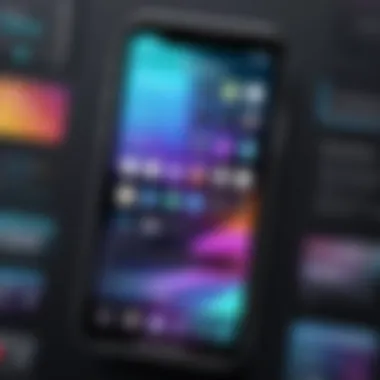
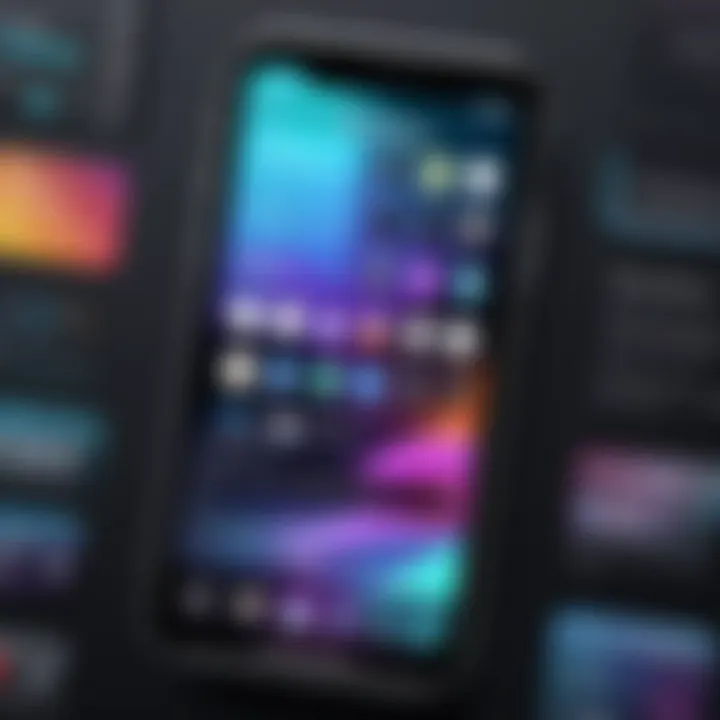
Lastly, Zedge stands out for those wanting to modify their device's sound and wallpaper. This app offers an expansive library of wallpapers and ringtones to choose from. Users can download and apply these materials directly to their devices, providing immediate visual and audio customization. By using Zedge, individuals can ensure their iPhone reflects their unique style, resonating with their personal taste in media.
Comparative Analysis of Customization Apps
The comparative analysis of customization apps is vital in understanding how different applications enhance the iPhone experience. Given the abundance of free options available, discerning which apps deliver superior performance and usability can significantly impact how users personalize their devices. This analysis serves as a guide to evaluate the strengths and weaknesses of popular customization apps, allowing tech-savvy individuals to make informed choices.
Performance and Usability
When assessing customization apps, performance and usability are paramount. Performance encompasses how quickly an app operates and its ability to manage resources efficiently. For instance, an app that consumes excessive battery or memory can be more of a hindrance than help. Usability relates to how intuitive and user-friendly an app's interface is. An app may offer extensive features, but if navigating those features proves challenging, users may abandon it.
Customers often consider these factors when evaluating app options. Smooth performance and clear usability lead to a satisfying user experience that encourages daily engagement. Some apps, like Widgetsmith, stand out for enabling users to create tailored widgets without sacrificing performance. Conversely, other apps may face criticism for lagging functionalities or cumbersome navigation, which diminishes their value.
User Interface Design
User interface design directly affects how users interact with customization apps. An appealing design can enhance engagement, making it easier for users to access features and settings. A clean layout with clear navigation allows users to explore customization options without frustration.
For instance, apps like Color Widgets feature vibrant and dynamic user interfaces that attract attention. Users appreciate clean lines and organized categories, as these design elements facilitate a smoother experience. On the other hand, apps with cluttered screens may leave users feeling overwhelmed. As a result, user interface design becomes a decisive factor in determining an app's popularity and longevity in a competitive market.
Compatibility with Latest iOS Versions
With frequent iOS updates, compatibility becomes critical for customization apps. As Apple releases new features and enhancements, apps must adapt to these changes to remain functional and engaging. Many users prefer apps that quickly update to support the latest iOS version because it ensures that they can take advantage of the newest functionalities.
Applications that lag behind in compatibility risk frustrating users who expect seamless integration. For instance, iOS 15 introduced features like Focus modes and redesigned notifications, prompting app developers to revise their tools accordingly.
More established apps tend to have a robust update mechanism, so they do not fall out of favor. In contrast, less popular options may struggle to keep pace, potentially leading to diminished user trust. This factor is crucial for anyone looking to customize their iPhone effectively.
"An app’s ability to adapt to technological advancements is not just an advantage; it is essential for maintaining relevance in the fast-paced tech environment."
Overall, a thorough comparative analysis of customization apps provides insight into the most effective tools available for users. By evaluating performance, usability, user interface, and compatibility, individuals can select apps that will truly enhance their iPhone experience.
Customizing Your iPhone: Practical Applications
Customizing an iPhone has become an essential practice for users who want to ensure their device reflects their personal style and enhances usability. Personalization not only improves aesthetics, but it can also optimize the functionality of the device. Various applications available enable users to make alterations that suit their individual needs and preferences. This section discusses practical applications available to users seeking to enhance their iPhone experience through effective customization.
Altering Wallpaper and Themes
Changing wallpaper and themes is perhaps the most visible form of customization available on the iPhone. It allows users to express their personality in a simple yet impactful way. Many apps offer a wide variety of high-quality wallpapers that cater to different tastes, from landscapes to abstract art.
Users should consider the visuals they select carefully, as these images serve as a backdrop for all apps and notifications. A well-chosen wallpaper can promote a sense of calm or motivation every time the user unlocks their phone. Moreover, apps like Zedge offer theme customization in addition to wallpapers. Users can create a cohesive look that reinforces their personal brand.
"Personalization through wallpaper can transform the user experience in significant ways, encouraging users to engage more with their devices."
Organizing Apps and Widgets
Another important area of customization lies in organizing apps and widgets. iPhones allow users to arrange apps based on frequency of use or by category. This can enhance access to important applications and streamline user workflow. With the introduction of widget functionality in iOS 14, users can now integrate widgets directly onto their Home Screen.
Apps like Widgetsmith make it easy to create customized widgets with different styles and functionalities. Users can select from various designs, choose colors, and even dictate what information is displayed. This level of organization not only aids in usability but also complements the chosen aesthetic of the device.
Setting Custom Shortcuts
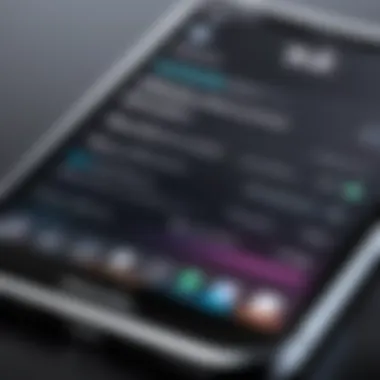
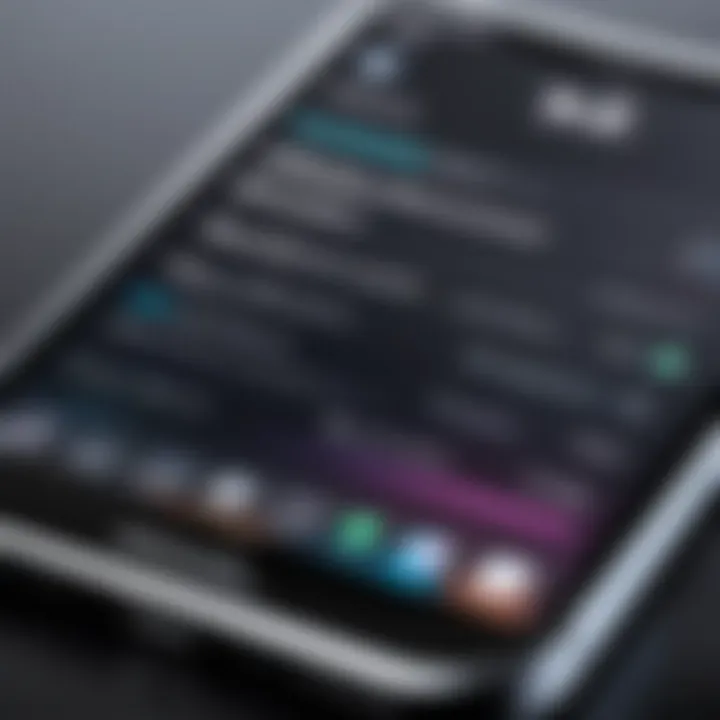
Custom shortcuts are another effective means for enhancing the iPhone usability. Apple’s Shortcuts app lets users create automated actions for a variety of tasks. This can range from sending a message to specific contacts to launching multiple apps with a single tap.
Shortcuts allow users to tailor interactions according to their routine. For example, users can set up a morning routine shortcut that dims lights, plays music, and provides weather updates with a single action. This kind of automation not only saves time but also amplifies the overall functionality of the iPhone.
Overall, individuals who take advantage of these practical applications will find their iPhone not only mirrors their personal style but also evolves into a more powerful and efficient tool tailored to their needs.
User Experience and Engagement
User experience and engagement play crucial roles in determining the effectiveness of free iPhone customization apps. A positive user experience ensures that users are satisfied with how easily they can personalize their devices. Engagement, on the other hand, relates to the sustained interaction a user has with the app.
User Feedback and Ratings
User feedback serves as a critical metric for assessing the quality and usability of customization apps. When users leave ratings and reviews, they provide insights into various aspects of the app. Effective apps often receive high ratings for their intuitive interfaces and functionality. For instance, users may comment on how easy it is to change wallpapers or set up widgets.
- Benefits of user feedback:
- It allows new users to gauge the app’s performance before downloading.
- Developers can identify areas that need improvement or new features to implement.
- High ratings often lead to increased visibility on app stores, attracting more users.
Feedback also helps create a community of users, who can share tips and ideas for customizations. Reading through reviews, users can find practical suggestions to enhance their iPhone's aesthetic appeal or performance. Overall, high user ratings signal trustworthy apps that enhance customization experiences.
Communities and Support Forums
Communities and support forums become essential for users seeking in-depth engagement and information regarding customization apps. These platforms facilitate discussions among users, allowing them to share experiences and troubleshoot issues.
- Key elements of these communities:
- Sharing Knowledge: Active users often share personalized tips and effective customization techniques.
- Support: Users encountering difficulties with specific features can seek help from others who may have faced similar issues.
- Updates: Community members often discuss updates or new features that can enhance app performance.
In forums like Reddit, users can find specific threads dedicated to customization apps. These threads may include recommendations, how-to guides, or information about upcoming app updates. Engaging in such communities not only enhances the user experience but also creates a sense of belonging among tech enthusiasts. Using resources like Reddit allows users to exchange knowledge and delve deeper into the customization capabilities of their devices.
Closure: Future of iPhone Customization Apps
As we look at the future of iPhone customization apps, it is clear that they will play a significant role in enhancing user experiences. Customization can go beyond aesthetics; it also has implications for productivity and personalization. The relevance of this topic lies not just in the current options available but also in how emerging technologies will shape these applications going forward.
Future customization apps are likely to integrate advanced AI features. These features could analyze user behavior, making contextual suggestions for wallpapers, app layouts, and more. This integration would reduce the time needed for users to make their devices feel personal and unique.
Additionally, the concept of seamless integration into various aspects of an iPhone is vital. Expect developments that enable customization tools to operate smoothly across different applications and settings, providing a holistic approach to personalizing the device experience. The interplay between user preferences and app functionalities will likely evolve toward more intuitive designs.
"The future of iPhone customization will be driven by user needs and technological advancements."
Emerging Trends and Technologies
Emerging trends in iPhone customization directly relate to the integration of artificial intelligence and machine learning. As these technologies develop, they promise to offer tailored suggestions based on how users interact with their devices. For example, an app may recommend new widgets when it recognizes that a user often uses specific features at certain times of the day.
Another trend is the rise of augmented reality. Imagine using AR tools to visualize how a new theme would look on your home screen before committing to the change. This capability could revolutionize how users engage with customization apps. Moreover, more manufacturers are beginning to open their design frameworks. This encourages third-party developers to create unique applications that cater specifically to user preferences.
The Role of User Personalization
User personalization remains at the core of any customization application. Users are increasingly seeking to express their individuality and preferences through their devices, and this trend is only growing.
The importance of fostering user-generated content cannot be overstated. Apps that encourage the creation of community-driven themes can enhance the overall experience while also promoting a sense of belonging among users. This kind of engagement can build a dedicated user base that contributes back to the app ecosystem.
Furthermore, feedback loops between users and app developers are crucial. Developers need to actively seek out user opinions and adapt their apps accordingly. This process will not only improve existing customization tools but also spur innovations aligned with user desires.
The combination of emerging technologies and user-centric design principles will undoubtedly pave the way for a new era of iPhone customization apps. As these trends materialize, staying informed will help users optimize their experiences and fully leverage the advances in this domain.







